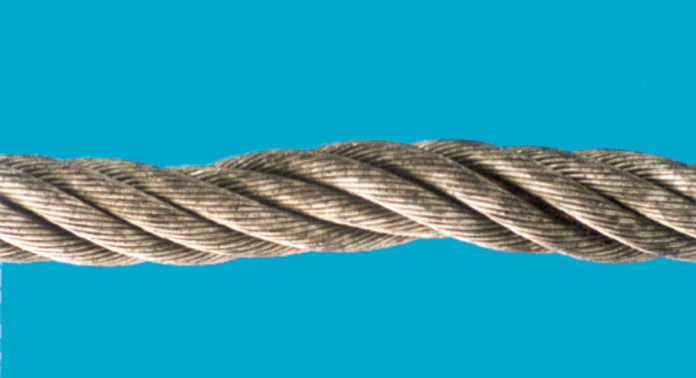Wire Rope Defects
By Colin Rice
Wire rope will develop defects during use through several different mechanisms each of which will affect the strength of the rope and therefore limit the working life of the rope.
This is the second article of Part 2 of our Technical Series on Wire Rope Safety. Click here for an outline of the entire Technical Series on Wire Rope.
Broken wires
The number of wire breaks will increase steadily during the life of the rope due to several factors but primarily due to fatigue caused by the rope travelling through sheave wheels. Neither the OHS Act nor the MHSA stipulates how many wires need be broken before a wire rope is discarded. In addition to the number of wires broken, attention must be given to the position and the concentrations of wire breaks as a localized concentration, although less than the number specified, will be sufficient reason to discard.
Broken wires due to fatigue.
Locating wire breaks
Inspection is done by first visually inspecting the full length of the rope. In some cases it can be helpful to spool the rope slowly through the hand. Special attention has to be paid and strong protective gloves must be worn. A soft cotton or similar type cloth held against a moving rope will be caught by protruding ends and thus detect the broken wires.
The detection of broken wires in the strand valleys is important but can be difficult. The use of a wire brush on a dirty, heavily lubricated rope can loosen, but not always remove old lubricant and the brush may have to be cleaned frequently with a solvent. Where solvents are used to clean the rope surface, they should be used sparingly and the rope section should be thoroughly lubricated afterwards.
Reduction in rope diameter
Reduction in diameter can be caused by abrasion, corrosion or a local failure of the rope core. It is recommended that a wire rope should be discarded when the rope diameter anywhere is reduced to 90 % of the nominal diameter.
Reduction in rope diameter due to failure of the inner core.
Corrosion
Corrosion may be external or internal, general or localized. It is recommended that a wire rope should be discarded when the surface of the wires is severely roughened or pitted, or if the wires are slack within the strands due to wastage.
Corroded wire rope leads to loss of metallic cross-section.
Rope deformation
Waviness
This deformation, while it may not necessarily affect the strength of the rope, can transmit pulsation and produce uneven rope wear. When the rope is laid on a level surface under no load, the maximum height of the “wave” should not be greater than the nominal rope diameter + 1/3, otherwise the rope should be removed from service.
Wave formation in wire rope.
Birdcage (Basket Deformation)
A birdcage develops when the outer layer of strands becomes longer than the inner layer or layers. The condition may occur as a result of incorrect fitting, tight sheaves, shock loading, incorrect use of a swivel or the application of a heavy load to a new rope before the strands have settled into position. Ropes with a birdcage should be discarded.
Increase in rope diameter
A local increase in rope diameter with the core easily visible between several covering strands can be caused by shock loading or, in the case of fibre main core ropes, by the absorption of moisture. A node is a justification for discard.
Increased rope diameter
Kinks
Deformation caused by a loop in a rope being tightened when the rope cannot rotate about its axis to release the torque. The tight bend or kink thus formed can result in a serious loss of strength due to unbalance in the lay lengths. Ropes with kinks must be discarded.
Kink caused by incorrect spooling of the wire rope on to the hoist drum
The next article in this series provides important guidelines for wire rope discard standards.






